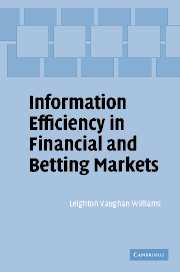Book contents
- Frontmatter
- Contents
- List of figures
- List of tables
- List of contributors
- Introduction
- Part I The concept of information efficiency
- 1 Information efficiency in financial markets
- 2 Weak form information efficiency in betting markets
- 3 Semi-strong and strong form information efficiency in betting markets
- Part II Selected readings
- Index
- References
1 - Information efficiency in financial markets
Published online by Cambridge University Press: 09 July 2009
- Frontmatter
- Contents
- List of figures
- List of tables
- List of contributors
- Introduction
- Part I The concept of information efficiency
- 1 Information efficiency in financial markets
- 2 Weak form information efficiency in betting markets
- 3 Semi-strong and strong form information efficiency in betting markets
- Part II Selected readings
- Index
- References
Summary
Introduction
This chapter examines some of the basic issues relating to the theory of information efficiency in financial markets and, in particular, some of the definitions and distinctions which have influenced the academic literature to date. Various empirical tests of information efficiency are then reviewed and assessed.
Section 1.2 outlines the concept of information efficiency and traces the development of the terms, definitions and meanings associated with this idea. Sections 1.3, 1.4 and 1.5 review the methods which have been applied to test for the existence of information efficiency, as variously defined, in financial markets.
The ‘efficient markets hypothesis’
In this section, a review is undertaken of the literature which has investigated the concept and existence of information efficiency in financial markets, and in particular the role and relevance of the ‘efficient markets hypothesis’ in our understanding of the operation of these markets.
The efficient markets hypothesis: reviewing the development of an idea
The concept of information efficiency in a market is contained in the so-called ‘efficient markets hypothesis’, a standard definition of which can be found in Fama (1991): ‘I take the market efficiency hypothesis to be the simple statement that security prices fully reflect all available information’ (1991: 1575).
The origin of the ideas central to this hypothesis can be traced back to pioneering work undertaken by Bachelier (1900) into the dynamics of stock price behaviour.
- Type
- Chapter
- Information
- Publisher: Cambridge University PressPrint publication year: 2005
References
- 1
- Cited by



